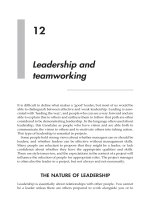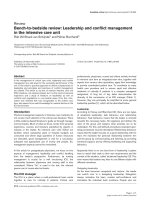Leadership and teamworking
Bạn đang xem bản rút gọn của tài liệu. Xem và tải ngay bản đầy đủ của tài liệu tại đây (115.03 KB, 12 trang )
12
Leadership and
teamworking
It is difficult to define what makes a ‘good’ leader, but most of us would be
able to distinguish between effective and weak leadership. Leading is asso-
ciated with ‘leading the way’, and people who can see a way forward and are
able to explain this to others and enthuse them to follow that path are often
considered to be demonstrating leadership. In the language often used about
leadership, this translates as people who have vision and are able both to
communicate the vision to others and to motivate others into taking action.
This type of leadership is essential in projects.
Some people hold strong views about whether managers can or should be
leaders, and whether leaders can be effective without management skills.
Many people are reluctant to propose that they might be a leader, or lack
confidence about whether they have the appropriate qualities and skills.
There are style issues too, and the expectations in the context of a project will
influence the selection of people for appropriate roles. The project manager
is often also the leader in a project, but not always and not necessarily.
THE NATURE OF LEADERSHIP
Leadership is essentially about relationships with other people. You cannot
be a leader unless there are others prepared to work alongside you or to
follow your lead. Traditional ideas about leadership have evolved through a
range of different concerns. Early ideas about leadership associated leaders
with heroism in battle, and this has led to a view of leadership as single-
minded, aggressive, risk-taking and arrogant. These behaviours are not
welcomed or appropriate in organizations that share basic values of respect
for equality and social inclusion, although there is some sympathy for this
heroic view of leadership in aggressive profit-making organizations. Another
traditional view that is now usually considered unacceptable is of leaders
being born with a natural ability into families that have powerful positions
through generations of ownership of land and property. Studies found that
the situation in which a leader was operating was also very important, and
that successful leaders often needed to balance one trait against another to
accommodate the issues that arose in a situation (van Maurik, 2001: 4–6).
More recent views have considered leadership as a role that is enacted in
different ways in different contexts. It is widely acknowledged that there are
different types of successful leaders. There are many examples of different
leadership styles proving successful when they are matched to particular
circumstances. There has been a long-standing debate about whether leaders
emerge naturally because it is a matter of personal characteristics, qualities
and charisma, or whether people can learn to be leaders. Increasing emphasis
on the need for people able successfully to lead change in organizations has
led to an expectation that managers, particularly senior managers, will be
able to exhibit at least some of the characteristics of an effective leader. There
is some consensus about what these characteristics are, and they are usually
described in terms of behaviour, competence or ability in relation to a par-
ticular context.
There are different types of leadership that are needed in different circum-
stances. This is not only about personal style, but also about the nature of the
setting and the direction of change. Leadership is often about leading pro-
gression in practice, but transformational leadership is valued when signifi-
cant change is needed and both vision and direction have to be developed.
Leadership in a project is essentially about achieving aims within the
boundaries of the project. A leader takes a particular role in the successful
completion of a project, but this does not always have to be the project
manager, and in different circumstances different people might become
effective leaders.
LEADERSHIP IN A PROJECT
A project creates a context of its own because of its clear aims and boundaries
that define what is inside the project and what is not. However, a project
140
Managing projects in human resources
always exists in a wider environment in which events take place that can
impact on the project and which the project can itself influence. Leadership
in a project is about successfully achieving the intended outcomes agreed for
the project. It might include successive revision of the nature of these out-
comes if there is frequent relevant change in the wider environment. To
achieve complete success, the activities of the project should respect the val-
ues of all those affected in any way. The focus is always on moving towards
achievement of the project goals in a way that fully encompasses its purposes.
Leadership is essential in a project to develop the initial idea, gain support
and funding, set the direction and strategy, and motivate and support the
activities. All these roles are also ones that a project manager often takes. A
project provides an opportunity for people who would not normally take
leadership roles in their day-to-day work to do so for the period of the project.
For this reason, people are often asked to manage projects to gain experience
in a leading role. A project manager does not, however, always have to lead
every aspect of a project. It is often a senior person in a service or organization
who initiates a project and who frames the proposal in terms of purpose and
key objectives, and who secures support and funding before appointing a
manager for the project. There may be experts in different fields who lead the
activities that contribute to the project. There may be people who feel very
strongly about the issues addressed by the project who lead in influencing
stakeholders and shaping opinion about the value of the project. There may
also be people who provide leadership in the teamworking necessary to
coordinate the activities of the project. The manager of the project may take
some or all of these roles.
A project can only be completed successfully if the people involved carry
out all the necessary activities in a coordinated way. To achieve this, leader-
ship and teamwork are necessary. Two aspects of leadership that affect the
relationships between those in the various project teams are the use of power
and style of leadership.
POWER IN LEADERSHIP OF PROJECTS
People with power can get things done and can stop things from happening.
The use of power on groups of people can cause misery and fear, or give the
confidence of approval and protection. Leaders are often thought to be pow-
erful people. Power is an energy that can be used in different ways according
to the source from which the power is derived and the purposes and values
of the person who holds the power. Power can be used to provide energy for
your own activities or to empower others. You need some power to lead or
manage a project because those who are to carry out the tasks and activities
Leadership and teamworking
141
need to be empowered to do it. However, it is often more important to be
able to work influentially within an environment where many people hold
power than to hold substantial power yourself.
The source of power confers the power but also constrains its use. In a
project there may be any of the following sources of power, each with related
constraints. Individuals have several sources of power, and the leader of a
project is often concerned with how to access and coordinate the various
contributions that others are empowered to make.
Position power
The project manager has a title and role that confers some power, but this is
dependent on the extent to which the role carries authority to take decisions.
The amount of authority held by project managers is crucial, as they will
usually not be seen to hold enough power if they always have to ask per-
mission of others before authorizing expenditure or action. This is also true
of team leaders, and a project manager who holds considerable overall power
can empower others through delegation of authority.
Resource power
This is the power that derives from control of resources. Resources for a
project may be agreed at a high level within an organization, but it can still
be very difficult for a project manager to access what is needed if those with
power over the resources do not cooperate. For example, if staff are only part-
time on the project and have line managers supervising their performance in
other areas of work, the line managers have power over those staff as
resources for the project. Such staff can feel that they are being treated as
objects owned by others if they are caught in power struggles between project
managers and line managers.
Expert power
This is the power held by being an expert in an area of work. Many tasks and
activities cannot be carried out without the skills, knowledge or experience
of an expert. This can sometimes be a problem in a project if an expert seems
inflexible and too bound by professional traditions in practice. In multi-
professional or multifunctional teamworking there is often a need for lead-
ership in negotiating between experts to enable appropriate actions to be
taken to progress the project.
142
Managing projects in human resources
Personal power
Everyone has the potential to influence others, and the degree of personal
power held is derived from the way in which others see you. Knowledge of
yourself and the impact you make on others is very useful in understanding
how much personal power you may have in different circumstances. It often
takes time to establish personal power in a new situation or with new col-
leagues. Your self-confidence, sense of direction and enthusiasm influence
others and are seen as leadership qualities.
Information power
This derives from the information held by people and the extent to which
they are prepared to share appropriate information with others. The power
can, of course, be used to hold back information that would be useful if
offered to others. One of the difficulties in managing a project is that relevant
information will often be held in a number of different places and by different
individuals. It can be difficult to identify the location of information as well
as to gain access to it. Sometimes it is easier for other people to gain access
because of their roles or areas of expertise. A project manager can often gain
useful information by working with those who are willing and able to share.
Political power
Some gain political power because they are elected to represent the views of
others. Holding an elected position can carry considerable power whether
the election is formal or not. For example, a community leader representing
the views of a minority can become the leader of an influential pressure
group. Informal political power can be gained by a person who is considered
to have an ability to influence others. Power is not only ‘given’ but is often
held because people allow it to be held by asking for suggestions or help or
support from those who are perceived as able to offer it.
STYLE IN LEADERSHIP OF PROJECTS
There is no one right way to be an effective leader. As every situation is dif-
ferent, leaders often have to be flexible about what style to adopt if they are
to be able to balance the needs of the individuals, the teams and the task.
Style is often discussed as a continuum of possibilities between the
opposing approaches of being very directive or consultative to the point of
Leadership and teamworking
143









